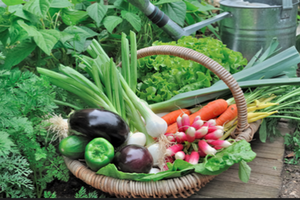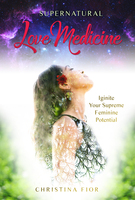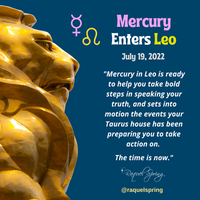
There’s a magic potion that women share as a common rite of passage. “It’s in the sauce.” The sauce is our moon blood. It’s our vaginal fluids and our erotic cum. It’s our Shakti, our kundalini elixir rising from our spine, cascading as the golden ambrosia of enlightenment from our pituitary. It’s our sweat, our saliva, and the sweet milk of our breasts. And it’s the cycles in our lives when our sacred fluids ebb and flow.
* * * * *
What have we done with the aspect of our female sumptuousness? For the most part, we’ve become clinical. We’ve forgotten how to celebrate our juiciness in its most pure and primal sense. It’s time to return to the garden, reignite the fountain of our flowing juices and give them center stage within the realm of our rising femininity.
Moon Blood: The Elixir of Life
As women, we’re dawning a significant, evolutionary rite of passage as we reacquaint ourselves with the deeper mystical aspects of our feminine physiology.
The very dynamics of emotions and bodily processes that often overwhelm us during our stages of puberty, menstruation, and menopause are the very energies that hold the key to our eloquent custody of primordial creative force, significant to the evolution of humankind.
These stages of our lives connect and deepen us to the mysterious tides of the celestial worlds and subsequent forces of nature: intimately and intuitively…fluidly and electrically.
The categorization of a woman being “bitchy” during her moon cycle (menstruation), and the emotions that accompany the feeling of wearing the world upon her shoulders, are misunderstood. In the deepest sense, they are evidence of the surging tides that are ebbing and flowing within her in order that she may expand and mature her internal capacities.
If the container of her being is too small, or if her bodily vessel is toxic, malnourished, or misaligned, she may endure intense discomfort, overwhelming and distracting her from this sacred internal process.
Until woman reacquaints herself with the significance of her initiatory moon blood rites intended for her evolution as a distinctive feminine agent, she may likely fall prey to the stereotyped encumbrances of these crucial life cycles. In the New Age, women are being summoned to explore the deeper meaning of “surfing the crimson tide!”
In an ideal world where a woman’s cycles are revered as a time for internal recalibration, she would arrange time off from work or extraneous demands at the onset of her menses. It would be a time for rest with no distractions so that she can reside within the space between the lines of her life.
In the nothingness of time and space, she can harness her internal powers, renew her energy resources, and regain her personal sovereignty. It is her time to be in her woman cave—her personal moon lodge.
The menses signify an innate, creative, primal urge present in all women. If it is not honored in her life, her sensitivities become heightened with the burdens she has garnered prior to her moon cycle, and her emotional tide comes crashing upon the shore of her life.
With unexpected explosion, she may personify what others may wrongly perceive as being “bitchy.” When she fails to honor herself in taking time to be in her woman cave, she can roar and lash out like fierce animal.
Romantic partners, friends, and family members would be wise to understand her nature and extend compassion, awareness, and honor during this time of woman: the powerful rite of passage of her Moon Blood.
In Barbara Walker’s Encyclopedia of Myths and Secrets, she explains that a woman’s Moon Blood was known by many cultures as our elixir of immortality or the “milk of the mother Goddess.” Revered as “sacred blood” in the Tantric traditions, it has been celebrated as the wine of poets and sages.
For a woman, it’s her time for “flow” as a precursor to the giving of life—energetically and physically. She bears the power of having the only blood that is released from the body naturally without puncture or provocation.
According to Walker, ancient societies of East and West knew that menstrual blood carried the spirit of sovereign authority. It was known as the medium of transmission of the life of a clan or tribe. Tribes in Africa and India have often placed a higher value on girls than boys because of their role of becoming carriers of the “blood.”
In India, menstrual blood is known as the Kula nectar, which is intimately connected with the life force of the family. During a girl’s first menstruation, she is said to have “borne the moon flower” that contains the soul of future generations. Biblically, menstrual blood is the flower (flow-er) that precedes the “fruit of the womb” or the bearing of child.
The ancient Taoists associated the scarlet color of moon blood with a woman’s sexual potency and powers of creativity—the yin essence that gives life to all things. In other cultures, it is believed that female blood and its color contain an active element of earth magic, whereas a man’s white semen represents a more passive and static element, contrary to modern, western views.
Many natives of indigenous cultures revere a woman’s menstrual period as her cycle when dreaming takes on special power. A window opens within a woman’s psyche two days before her period begins. During her moon cycle, she can step through this window into other worlds.
For this reason, it is believed that women are naturally keener and wiser divine sorcerers than men. Indeed, it is time for women to uncover an ancient secret they possess inside.
Earlier history reveals that women once were more intrinsically and ceremoniously involved with the earth’s cycles as well as their own, evidenced by their sacred practices. They were the Goddesses of White Magic—the sacred guardians of Earth and her evolutions.
Mystic author Diane Stein revealed in her book, Casting the Circle, that originally, a woman’s menstrual cycle initiated the first form of calendars and the counting of days. These moon calendars, carved in rock, were discovered as early as 300,000 BCE. Her studies of the “original wand of power of rulership and magic” was revealed as the “rod” of the menstrual/birth/lunar calendar.
Menstrual blood also has generative properties for the giving and sustaining of life. Native tribeswomen once practiced returning their sacred life-giving blood back into the earth. Women would sit over seeds and let their scarlet fluid flow directly onto newly planted seedlings— which studies has shown infuses seeds with growing power.
Strange, you say? For many of us, we have grossed ourselves out of loving our blood flow and have unwittingly lost the significance of our organic connection to our sacred, primal roots.
Some pioneering women of today actually collect their menstrual blood in cups and transfer it into jars. They combine their blood with water and use it as a solution for watering their plants. As you purify your body, you too can experiment by watering some plants with your moon blood solution while using plain water on other plants to compare the difference. Your moon blood’s life-giving power may amaze you.
It is interesting to note that the element of copper (as previously mentioned) runs in the veins of the earth just like it flows through the veins of the human body. It has a significant Venusian relationship to women, as copper is apparent in our blood.
In fact, we as women contain nearly 20% more copper in our blood than men, whereas men contain higher levels of iron. The copper ratio in a women’s blood also correlates to the quality of her menstrual cycle.
Copper levels significantly increase in a pregnant mother’s blood to strengthen the placenta and nourish the fetus. As the time of birth approaches, copper levels decrease, and iron levels increase. Taking the pill inhibits a woman’s monthly rhythm of serum copper, while copper excess after pregnancy can lead to postpartum depression.
Our female sex organs are rich in copper which is used as fuel during sexual intercourse. So, replenishment is key. Foods that contain some of the highest natural copper levels are apricots, leafy greens, shitake, sweet potato, beans, liver, garlic, nuts, seeds, and spirulina.
Sadly, many women have so dishonored their bodies by the intake of unwholesome foods, alcohol, prescription/recreational drugs, and unclean water, that their menstrual blood has become filled with toxins.
The menstrual cycle, for many, often results in a “double duty” function of releasing both unfertilized eggs and excreting toxins from the body, often plugged up by today’s synthetic tampons which tend to revert toxic blood back into the porous vaginal wall and ultimately into the bloodstream. A healthier practice could be to wear 100% cotton tampons or even cotton pads whenever possible, allowing the moon blood to flow out of the body naturally.
You can reintroduce yourself to your sacred moon rites by rejuvenating your body with fresh organic foods, pure spring water, and hormone-nourishing herbs, along with creating a space for internal reflection during your moon cycle. It’s an opportune time to ground yourself in nature, meditate, read inspiring works, journal, breathe deeply, use aromatherapy, listen to uplifting music, and emotionally express yourself using Wowza’s Five Inner Languages outlined in Love Medicine Number 6.
Even if you no longer menstruate, you can celebrate the cycles of life, death, and rebirth within you by tuning into the earth’s lunar cycles. Enlighten those living with you when you are entering your woman cave, your moon lodge of mystical powers.
Scent of a Woman – Musk of a Man
Many of us have also acquired a misunderstanding as to the power of “natural” olfaction (body odor)—one of our most significant sensory modalities. Billions of dollars are spent each year, especially in modern, industrialized countries, to manufacture a modification of the way we smell to one another.
Both men and women feverishly scrub and deodorize their bodies with soaps and scented shampoos topped off by lotions and potions that replace the body’s natural odors, which we then unwittingly discard down the drain.
There’s an obvious contradiction here. Why do we, as humans, work so hard to change the way we smell rather than embracing our natural scent? One reason comes to mind. People are very toxic. They are out of touch with nature, and thus their natural essence.
When their glands excrete oils, they smell putrid because they are excreting a poisonous chemical soup that’s been swirling around in their bloodstream. People produce toxins, not only from the foods and fluids they take into their body, but from the chemicals created by their own thoughts and emotions. People can increase lactic acid and other noxious chemicals in their bodies from stressful, negative thinking, thus repelling people from them.
Researcher David Wolfgang-Kimball, in his 1992 article on the subject, points out that pheromones are our body’s natural pleasure chemicals. They are a sensual way in which humans and animals communicate sexual attraction toward their own species.
When animals communicate attraction, they commonly release pheromones from their skin, urine, feces, and even breath. Most research indicates that the central odor-producing organ in humans is the skin, although I would add that the breath is also a significant pheromone communicator.
Pheromones and other scents are released from the skin's apocrine sebaceous glands. These sebaceous glands begin to develop during puberty in both sexes and become located all over the body’s skin surface. They are in high concentration in specific areas including the mouth and lips, eyelids, and outer region of the ears. Hair growth and hair tufts that accompany the underarms, nipples, and pubic, genital, and anus regions are some of the most powerful distributors of pheromones.
An interesting study by Dr. Alex Comfort reveals that in the past three centuries, the age of onset of menstruation for girls has been impacted by the age at which they are allowed to spend more extended periods of time with boys in school and social settings.
The hair growth/gland relationship, especially during puberty, indicates that body odor and its dispersal are linked to sexual development. This pheromone-olfactory exchange explains the sudden sexual arousal that occurs during the developing years, and when in the company of another from the opposite sex.
Studies by Le Magnen and Doty reveal that women possess an acute ability to smell musk that is present in a man’s steroids, testosterone, and chains of other compounds likely involved with his biological activity located in the various regions of his body. Men are natural, musky odorant machines! You might say they are the original musk producers.
Women are especially responsive to these substances around ten days following her menstrual cycle during ovulation—her peak fertility period where sensitivity is greatly heightened. When a woman’s level of estrogen peaks in her blood during ovulation, her desire for sexual intercourse soars, and she’s much more likely to experience an orgasm during this time.
So, when men secrete their musky substances in their sebaceous glands, women are most drawn to them during fertile times. This indicates the tremendous, intimate olfactory-sexual role our pheromones play for romantic exploration and procreation.
On the contrary, women on the pill, pregnant women, and post-menopausal women are less sensitive to these substances. Durations of menstruation, pregnancy, and menopause show a predominance of progesterone in the blood which generally results in a reduced sensitivity to a man’s pheromones.
A menopausal woman, however, can reignite her sensitivities by regenerating her endocrine/hormone function through adopting a custom-designed holistic lifestyle, eating a superfood diet, nourishing her adrenal glands, and finding a wholesome avenue for expressing the tide of her emotions.
Researchers have discovered that a woman’s vaginal cum (or secretions) likely contains sex pheromones (or "copulins" as termed by one researcher). They found that human vaginal secretions contain various small (C2 to C6) fatty acids, with acetic acid predominating and increasing until ovulation, and then decreasing as menstruation approaches.
Women on birth-control pills do not show this mid-cycle increase and have a lower overall fatty acid content. These fatty acids, or "copulins," are suspected to produce a sexual trigger or desire for copulation, especially in women.
It makes sense, then, that “copulins” along with other essential fatty acids are key to a flourishing woman’s body. They reveal themselves as a synergistic blend of her “unguent” or “sacred oil.” A woman needs to be oily and juicy. It keeps her tissues subtle, her body moist, and her vagina luscious and lubricated.
During less fertile times or even during menopause, she can activate her juices with specific plants, oils, aloe-based lubricants, and personal practices. Organic evening primrose oil, borage seed oil, sesame oils, macadamia oil, walnut oil, hemp oil, jojoba oil, and other omega 3 oils are all extremely nutritious oil unguents for women.
Red raspberry, black cohosh, fulvic and humic acids from high altitude soils, as well as maca, suma, and other indigenous plant superfoods can replenish her body’s natural feminine superpowers.
In the Garden of Venus, we recognize that our pheromones are intrinsically connected to our primal instincts as well our emotional tides and our higher intellect. Rather than splashing on chemically produced odors that program our senses to respond to a manufactured behavior or desire, we can look at our body’s natural odorants as signals to our highly sensitized creative impulses. Pure essential oils are synergistic with nature’s cellular intelligence. They provide a wonderful array of distillates that naturally enhance our own chemical cocktail and personal pheromone apothecary.
We’ve only begun to understand how to dance with our pheromones and the object of our desires. Our first step is to purify our bodies with natural spring waters and wild plant foods that are bursting with natural, golden-ratio cellular intelligence. Our next step is to purify our thoughts and feelings so that our pheromones are secreting an innate, alluring, natural essence. These maximize our juiciness and attract to us the connections that resonate with our highest creative potential.
The Sacred Gateway
A woman’s sexuality is her treasure chest. Her open, trusting heart is the precursor to intimacy. Her womb is the gateway to her innermost sacred self, awakening the beholder to the realms of divine love.
Her female bush is her feminine garden, emitting her signature fragrance. Just as we prune and trim our green foliage, the Shakti Goddess has her way of keeping her female bush trimmed, and her sacred gateway clean and sweet with floral waters.
Sexuality and creativity are intrinsically linked. They are laced as an ancient tenet of primal power and artistic expression which is evidenced in every culture throughout history.
This is the path of the Tantric Goddess—where woman embodies her primal life force as a sacred form of self-expression in consort with the divine. The key, then, for us as women is to retain or regain our juicy essence by using our sexuality wisely and creatively in the many ways we move, speak, and express ourselves.
The sexual act itself plays out as a primal dance of creation as the masculine and feminine energies become one. Therefore, it is so important for women to choose wisely when it comes to sexual exchanges with a partner.
Our sexual fluids are the nectars that blend and become part of our interior terrain. These fluids (the musk, the copulins, and the sperm) can provide the exchange of nourishment and feelings of bliss when the qualities of love, care, and respect are in the mix.
While spontaneous sex with a new partner can be extremely erotic and fulfilling, woman must use discernment to safeguard herself from taking in a partner’s energies and fluids that she might later regret. There are always exceptions to the rule, yet partnerships by and large that have blossomed from building trust in one another over time, create the most optimal environment for a pleasurable, long lasting sexual exchange.
Women, by the nature of being feminine receivers, are the receptacles of a man’s fluids and the quality of consciousness retained in those fluids, whether we use contraceptives or not.
How do copulins fit into the picture here? According to researchers Karl Grammer and Elizabeth Oberzucher, when a man gets a whiff of a woman’s copulins, his testosterone levels spike. Copulin odor can influence a man’s mind by heightening his sexual attraction toward a woman, regardless of her visual attractiveness.
During this time, she has the supreme ability to enchant him using trigger words or actions that draw him to her in both the immediate and latent sense. A man’s hypothalamus becomes flooded with copulins, causing his brain to become idle until he receives the signal from his female romantic interest. This is known as “coupling.”
For the unevolved man, this explains why he can seem to be a “mindless, heat seeking missile” when it comes to his pursuits of female sexual companionship. Over time, the presence of a woman’s copulins and hormonal scent can become addictive to him. Like the emperors of old, he may rotate women to prevent himself from falling under the spell of one woman’s copulins, because a part of his psyche is not under his conscious control.
The higher order of sexual exchange between a man’s lingam (penis) and a woman’s yoni (vagina) as an aspect of one’s tantric practice includes a heightened, erotic sensitivity to the couple’s “energetic” connection and the exchange of breath, rather than limiting the exchange to a rudimentary form of thrusting and releasing.
This co-creative act involves ancient techniques that respectively re-channel feminine and masculine orgasms and ejaculation’s back into the body, rather than being released from the body where the energy becomes dissipated. This internal energy explosion stimulates the kundalini (Shakti) fire that surges from the base of the spinal column to the crown, promoting heightened levels of ecstasy.
Individuals can also experience levels of extraordinary cellular rejuvenation from this sexual practice. I highly recommend The Tao of Sexology by Dr. Stephen Thomas Chang for further exploration of this vast subject.
This dialogue focuses on the male-female sexual exchange. Whatever a woman’s sexual orientation, there is a giving and receiving of energetics, creating a unique tryst between loving souls. Each woman plays her unique role in the creative sexual exchange, the currents of which may alternate at times.
Tantra is its purest essence represents a vastly evolved spiritual lifestyle that far surpasses the sexual act. It is the path of absolute co-creative connectivity with divine love and cosmic intelligence.
Celibates as well as sexually active individuals can practice a spiritually tantric path. Importantly for lovers, spiritual tantra is a vital precursor to sexual exchange and the experience of a deepening soul connection between them.
In the Tao of Sexology, Dr. Chang points out that the erotic zones on a man’s lingam and those found in the depths of a woman’s yoni serve another vital function. These zones intelligently correspond to various internal organs in the body. When penetrated and stimulated, they exercise and refresh the organs, and thus sex becomes the ultimate internal body workout!
As women, we give of ourselves in a way that our masculine counterpart hungers for. We give the nectar of our innermost sacred self which is why it’s such a natural act for us to bond after sex. Our souls can energetically create a tryst with someone, heightening our serotonin (bonding) chemicals, because within the exchange of fluids are the subtle messengers or the codes of the partners life story.
Many women are beginning to exercise greater discernment when it comes to taking in our partner’s codes. If we’re completely honest, we women instinctively know whether a sexual exchange with someone is in resonance with our soul’s higher purpose, or if it would set our course in a direction of struggling through unnecessary karmic entanglement.
The chemical bonding that occurs during sex may be difficult for her to shake. As Goddesses of Love, it’s essential that each of us, as women, exercise our sovereign power to choose, despite the agenda of others. Modeling self-respect sets the stage for attracting true and lasting love.
A woman who desires to become pregnant and give birth to higher evolutionary beings is wise to first heal the former trauma and pain registered within her womb from former trysts—even perhaps from trauma experienced as a fetus when growing inside her own mother’s womb.
A woman can place her hands over her womb, and with compassionate self-inquiry, identify any emotional wounds inside—express them, forgive them, and release the shame. She can forgive any offenders and intentionally severe any negative energetic cords or holding patterns of painful memories that may have been attached to her.
Through her connection to the portal of her heart, she can access radiant love coming from the heart of Divine Mother, and bathe herself in serene, liquid light cleansing her womb as she tones soothing frequencies using vocal toning or Mother Hum as explained in Love Medicine #6.
Whether or not we are in a sexual partnership, we can heal the past and lovingly fulfill the desires of our innermost being by embodying tantric self-love practices, and by using the power of our creativity in every area of our lives. Beauty itself is born out of love’s creative act between heaven and earth. Nature, in all its grandeur, is the great example of the intelligent exchange of primal power and artistic expression.
Yoni Steaming
Yoni steaming, also known as vaginal steaming (v-steaming), is a healing practice whereby a woman sits with her uncovered vagina on a yoni steam chair, or she squats over an open bowl of steaming water prepared with a fusion of medicinal herbs—as she allows the warmth of the herbal blend to permeate her vaginal exterior.
Herbs such as basil, dandelion, dong quai, oregano, rose, rosemary, sage, lavender, motherwort, mugwort, and yarrow have been used by women and healers around the world. It has long been held as a sacred healing tradition, having been passed down from generation to generation.
Yoni steaming can be used to intimately connect with your body and heal your sacred gateway. It is a practice that is being rediscovered by evolving supernatural medicine women throughout the Western world, and revered for its amazing, life-giving benefits.
Throughout history yoni steaming has been used for:
• Reducing menstrual pain and flow, bloating and fatigue.
• Helping regulate menstrual cycles while boosting fertility.
• Healing and toning the reproductive system after birth.
• Moisturizing the uterus and restoring balance and strength.
• Helping reduce fibroids, ovarian cysts, and endometriosis.
• Aiding the repair of a vaginal tears, scars, and hemorrhoids.
• Alleviating vaginal infections while promoting healthy odor.
• Easing menopausal symptoms, including dryness or pain.
• Detoxifying the womb of stored toxic buildup and emotions.
Childbirth: Fulfillment of the Evolutionary Cycle
The creation of life unfolding within a mother’s womb continues to be a sacred mystery. The moment the soul has triumphed as a new life force inside the liquid cocoon of her uterus, the exquisite alchemy of cell multiplication takes root. Like a microcosm of the universal womb, each soul holds within them the spiraling worlds within worlds of unlimited potential.
A mother-to-be has the supreme opportunity, as a life-giving alchemist, to positively impact her child during the gestation process. As she lovingly communes with their pre-born child, plays music, hums, sings, reads out loud, and even exposes her child to multiple languages, she significantly advances her child’s evolutionary process.
The information and stimulus that her child receives while in the womb activates neurons in the brain, and generates a wide range of cellular activity, influencing the soul’s growth patterns.
Author Patricia K. Kuhl, PhD is internationally recognized for her research in early language and brain development. Her work has played a major role in demonstrating how early exposure to language alters the brain.
She has stated that by the time a child is born, they are already familiar and bonded with their mother’s voice, because they are actively processing information in the womb. A pregnant mother’s movement while talking or singing is key in helping a baby’s cognitive development more so than music to the belly.
It's best to avoid using a speaker or mechanical device to project music into the belly unless it is very soft and serene. The womb is already a noisy place for the gestating child, filled with the amplification of bodily functions from the mother.
So soft melodious tones generated by her own vocal cords comforts her baby with the familiarity of her voice, strengthens the maternal bond and fosters her baby’s ability to learn and discern during the pre-birth cycle. Newborns can tell the difference between their mother’s native tongue and foreign languages just hours after they are born.
An active, engaged father-to-be is a vital contributor to his child’s internal development, in loving concert with the mother. Together, their unified field of love, their hands on the mother’s belly and their gentle vocal tones palpably reinforce the family bond to the budding, intelligent life that was made from the fruit of their love.
During the birth cycle, a baby is suddenly confronted by an immense pressure as it begins squeezing it way through a dense, narrow passageway. Its senses are feverishly fielding a range of imposing sensations like noise, light, temperature, and a peculiar impression we call “touch.” The baby extends its shaky arms, and in a fragile effort to proclaim its identity he/she wails out his/her first primal cry, I’m here! But who am I?
As each of us has emerged from celestial spheres, our entrance into the earth (the world of form and fables) results in a form of “embodiment shock,” and for a time, we may have become forgetful of our core identity and prior sublime existence. We’ve entered a very dense platform of experience, poised to participate in a live theater of sorts, fraught with complicated rules of engagement.
For a time, the comfort of our mother’s milk, her sacred fluids, and the codes of nature within those fluids, are transferred to us. The familiar warmth of her body chemistry assures us that our primal needs are met. Yet, even amidst the most nurturing of environments, our souls are impacted by the harshness of the physical realm.
It is said that during the birth process, there’s an explosion of light that enters earth’s atmosphere—the announcement of the creative life force made evident in the world of form. Birth is also known as a time when a cosmic resonance takes place with some of the highest known levels of pi frequency on the planet. Its eminence is unique to everyone, as pi is infinite and never falls into a repeating pattern.
If you look at an infant’s first photos at birth, we see visibly wondrous, new creatures emanating an “other-worldly” Buddha-like appearance. The infant’s image is often accompanied by various hand positions that, in many cases, prove to be legitimate hand “mudras” highly revered by Eastern culture. A skeptical, adult eye may dismiss this phenomenon as fantasy, nonetheless, the child’s natural descent from universal intelligence is palpable.
Metaphysical scholars believe that the soft unsealed hole (fontanel) at the crown of the baby’s scull represents the baby’s “lifeline” to cosmic intelligence (the crown chakra of enlightenment), which is still very much intact at birth. The fontanel is a fibrous membrane between the plates of bone in the skull. Its name comes from an old French term meaning “little fountain,” and is truly a biological miracle.
Infants arrive with a total of six fontanels, the most significant being the larger anterior and smaller posterior fontanels. They provide a window for us to determine the child’s health and brain development. In most babies, the anterior fontanel will get a little bigger during the middle part of the first year as new neurons are laid down and the brain grows exponentially.
As this fontanel begins to naturally seal (timing varies from 9-18 months), the baby’s attention and memory of his or her celestial connection begins to wane, and the child’s brain faculties become increasingly responsive to outer stimulus. They soon begin to discover the use of their hands and other extremities for more worldly functions.
“Regenopause”: The New Menopause
After a woman passes the phases of her childbearing years, she enters a new phase of her life. Her energies move from physiological potency…to internal potency…to external potency. She discovers she has free agency to give birth to her authentic self, having garnered the internal powers of self-regeneration.
Her purpose expands as she draws upon her inner fount of wisdom and she becomes a new species of the ever advancing, “evolutionary woman.” She becomes a pivotal player then, in the higher evolution of humankind.
The late, great Barbara Marx Hubbard, Futurist and Founder of The Foundation of Conscious Evolution, left us with this great understanding:
We call this new phase of life “Regenopause.” It’s a pause in the life cycle of the older woman when the possibility of remaking herself by choosing from her deepest impulse becomes evident.
As our bodies age, creativity and spirituality awaken. A dynamic motivation arises to move toward regeneration and renewal, to develop new vitality, and to contribute to the greater whole.
It has been suggested that there is a cellular potential that is activated when women get vocationally aroused and say YES to their life purpose. Perhaps women are triggering new hormones through their passion to express and create, that releases dormant potentials within them.
Barbara suggests that there is a deeper plan or design that is arising in us all at this moment in time when the planetary system is in crisis and need. She encourages us work together in a way that women throughout history have done in times of emergency.
Barbara adds:
Women entering Regenopause would become a vital resource to connect the larger human family, and to act as models and mentors for women with less experience called to this purpose.
As essence meets essence, as women develop true connections with each other, the wisdom and experience of older women working with the energy of the young would unleash a vast evolutionary potential for lasting change into the world.
It's in the reach of my arms
The span of my hips,
The stride of my step,
The curl of my lips.
I'm a woman,
Phenomenally.
Phenomenal woman,
That's me.
—Maya Angelou
* * * * *
This article is taken from Christina's Book:
SUPERNATURAL LOVE MEDICINE: Ignite Your Supreme Feminine Potential






